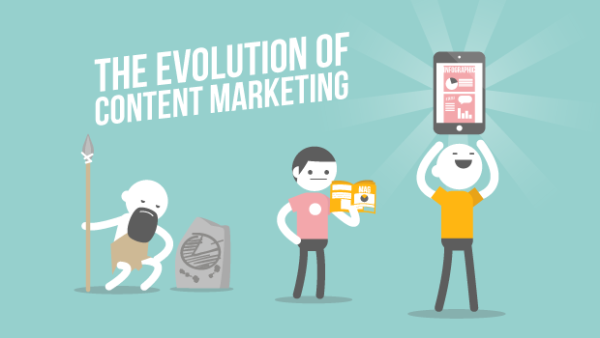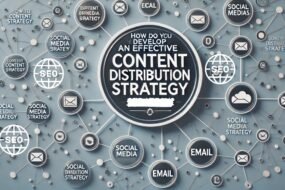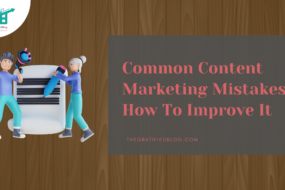
In the ever-evolving digital marketing landscape, content marketing has become a potent tool for businesses to connect with their intended audience, establish brand recognition, and drive conversions. However, creating and distributing content is only half of the equation.
To guarantee your content marketing strategy is aligned with the right track, you must measure its effectiveness. But how do you do that?
In this article, we explore one of the essential ways to gauge the success of your content marketing efforts, which is by determining “What Is One Way To Measure The Effectiveness Of Your Content Marketing Strategy?”. We will delve into how to measure content marketing success effectively.
The Evolution Of Content Marketing

Content marketing has come a long way since its inception. What began as a simple blog post or occasional social media update has evolved into a complex ecosystem of content types and distribution channels.
This shift is mainly due to changing consumer behaviors and expectations. Today’s consumers are more discerning, tech-savvy, and time-constrained than ever before.
They demand value from the brands they interact with and expect relevant, high-quality content delivered to them in the correct format at the right time.
As a result, content marketing has become a multifaceted discipline encompassing blog posts, videos, infographics, podcasts, webinars, social media updates, email campaigns, and more. The variety of content formats is impressive, and this diversity allows businesses to cater to a broader audience.
However, it also raises a critical question: What methods do you use to gauge the efficacy of your content marketing efforts? What is your strategy when dealing with so many variables and ensuring that the effectiveness of content marketing aligns with your goals?
The Importance Of Measuring Content Marketing Effectiveness
Assessing the efficacy of your content marketing approach is vital for several reasons:
- ROI Assessment: To determine if your content marketing efforts are worth the investment, you must measure the return on investment (ROI). This entails evaluating whether your strategy generates revenue, reduces costs, or achieves other measurable business goals.
- Improvement and Optimization: Effective measurement provides insights into what’s working and what’s not. By understanding the strengths and weaknesses and evaluating the outcomes of your content marketing endeavors, you can inform your decisions with data for improvements.
- Resource Allocation: Allocation of resources is a crucial element in any marketing strategy. Efficient measurement helps you allocate your resources (time, money, personnel) where they will have the most significant impact.
- Audience Insights: Through measurement, you gain a more profound insight into your audience, enabling you to customize your content. To their preferences and needs more effectively.
- Competitive Edge: Staying ahead in digital marketing requires continuous adaptation and improvement. Measuring effectiveness enables you to outperform competitors who must be more diligent in evaluating their strategies.
Defining Content Marketing Metrics
Content marketing metrics can be classified into various categories. These categories provide a comprehensive view of your strategy’s effectiveness:
- Consumption Metrics: These metrics focus on how many people consume your content. They include metrics like page views, video views, downloads, and social media engagement (likes, shares, comments).
- Engagement Metrics: Engagement metrics gauge how deeply your audience interacts with your content. Common examples include time on the page, click-through rates, bounce rates, and social media engagement.
- Conversion Metrics: Conversion metrics are the most critical for assessing the impact of content marketing on your business goals. They encompass metrics like conversion rate, lead generation, and sales attributed to your content.
- Retention Metrics: Retention metrics help you understand how well your content retains your audience’s interest. They include metrics like subscription rates, email open rates, and customer retention.
- Sharing Metrics: These metrics assess the virality of your content. They include the number of shares, retweets, and forwards.
- SEO Metrics: SEO metrics measure your content’s performance in Search Engine Results Pages (SERPs). They encompass metrics like keyword rankings, organic traffic, and backlinks.
- Social Media Metrics: For businesses active on social media, metrics like follower growth, engagement rates, and click-through rates on social posts are essential.
- Brand Awareness Metrics: Brand awareness metrics include surveys, social listening, and sentiment analysis to gauge how well your content is helping to build your brand’s reputation.
- Cost Metrics: Cost metrics measure the expenses of creating and distributing content. This includes the cost per click, lead, and overall content marketing budget.
Choosing the right metrics to focus on largely Relies on your business objectives and the strategy you employ for content marketing. While trying and measuring everything is tempting, concentrating on a few key performance indicators (KPIs) that align with your objectives is often more practical.
What Is One Way To Measure The Effectiveness Of Your Content Marketing Strategy?
One way to measure effectiveness is through conversion metrics. Among the various content marketing metrics, conversion metrics stand out as one of the most critical methods to gauge the effectiveness of your content marketing strategy.
Conversion metrics track your audience’s actions after interacting with your content and tie directly into your business’s bottom line. Let’s delve into some of the essential conversion metrics you should be tracking:
Conversion Rate
The conversion rate represents the percentage of individuals performing a desired action after interacting with your content. This action could be anything from signing up for a newsletter, downloading an ebook, purchasing, or requesting a demo.
An elevated conversion rate signifies that your content effectively persuades your audience to take the next step in your sales funnel.
To compute the conversion rate, divide the total number of conversions by the overall visitor count. Or interactions and multiply by 100 to express it as a percentage. A conversion rate of 2% means that 2 out of every 100 visitors took the desired action.
Lead Generation
Lead generation metrics track how many leads your content marketing strategy generates. A lead is a person or organization that has expressed interest in your product or service by providing their contact information. These leads are potential customers who have moved a step closer to purchasing.
Effective lead generation can help fill your sales pipeline, with prospects more likely to convert into paying customers. Measuring lead generation involves keeping track of the quantity and quality of the leads produced.
Sales Attribution
Sales attribution is crucial for understanding the direct impact of your content marketing on revenue and tracing each sale to the specific content or touchpoints that contributed to the conversion.
This can be a complex process, but knowing which content pieces or campaigns are most effective at driving sales is essential.
Various attribution models, such as first-touch, last-touch, and multi-touch attribution, help determine how credit is assigned to different touchpoints along the customer’s journey.
A solid sales attribution system can provide valuable insights into which content drives revenue.
Customer Acquisition Cost (CAC)
Customer Acquisition Cost (CAC) is a critical metric for understanding how much it costs to acquire a new customer through your content marketing efforts.
To calculate CAC, add up the total costs of your content marketing (including personnel, software, advertising, and production costs) and divide it by the number of new customers acquired during a specific time frame.
A lower CAC indicates that your content marketing is cost-effective, while a higher CAC suggests that you may need to refine your strategy to acquire customers more efficiently.
Bounce Rate
The bounce rate measures the percentage of visitors who land on a page and then leave without interacting with the page or taking any further actions. A high bounce rate can indicate your content could be more engaging and relevant to your audience.
Lowering the bounce rate is often a primary goal in content marketing, as it means more visitors stay on your website and potentially convert into leads or customers. This metric is significant for landing pages where you want to capture visitors’ attention and encourage them to explore further.
The Role Of Conversion Metrics In Content Marketing
Conversion metrics, as mentioned, are a powerful method for assessing the efficacy of your content marketing strategy and they serve several crucial roles:
- Alignment With Business Goals: Conversion metrics are closely tied to your business objectives. They allow you to measure how well your content marketing efforts contribute to achieving those goals.
- Focus On Impact: Conversion metrics help you identify the content that directly impacts your bottom line. This can be especially valuable for resource allocation, as you can prioritize and invest in content consistently delivering results.
- Continuous Improvement: By tracking conversion metrics, you can recognize aspects within your content marketing strategy that need improvement. Whether it’s refining your calls to action (CTAs), optimizing landing pages, or enhancing the quality of your content, conversion metrics provide actionable insights.
- Optimizing The Sales Funnel: Conversion metrics are crucial for optimizing your sales funnel. You can identify where potential customers drop off or lose interest and make necessary adjustments to keep them engaged and moving through the funnel.
- Data-Driven Decision-Making: Conversion metrics are based on data, not assumptions. They provide objective information about determining what is effective and what is not, enabling you to make well-informed decisions about your content marketing strategy.
Challenges In Measuring Conversion Metrics

While conversion metrics offer valuable insights into the effectiveness of your content marketing strategy, they are not without their challenges. Here are some common issues you might encounter when measuring conversion metrics:
- Attribution Complexity: Attribution modeling can be complex, particularly in a multi-touchpoint customer journey. Deciding how much credit to assign to each touchpoint can be challenging.
- Data Integration: Gathering data from various sources, such as your website analytics, CRM, and email marketing platform, can be cumbersome and may require integration solutions.
- Defining Conversions: Defining a conversion can vary among businesses and goals. It’s essential to have a clear and consistent definition to measure accurately.
- Short-term vs. Long-term Metrics: Some conversion metrics, like lead generation, may yield short-term results, while others, like sales attribution, require a longer-term perspective. Balancing these metrics is necessary for a comprehensive evaluation.
Best Practices For Measuring Conversion Metrics
To overcome the challenges and get the most out of conversion metrics in measuring your content marketing strategy’s effectiveness, consider these best practices:
- Set Clear Goals: Define specific and measurable goals for your content marketing. This includes determining what constitutes a conversion for your business. Having precise objectives will make it easier to track progress.
- Implement Conversion Tracking: Utilize tools and software that can track conversions accurately. Popular options include Google Analytics, marketing automation platforms, and CRM systems. Ensure that you have proper tracking in place to monitor conversions effectively.
- Consistent Data Gathering: Ensure your data is consistently gathered and integrated across all relevant platforms and channels. Regularly review your data to detect any discrepancies or issues.
- Use A/B Testing: A/B testing (or split testing) can help you optimize your content for better conversion rates. Experiment with content elements like headlines, images, CTAs, and page layouts to see what resonates best with your audience.
- Analyze The Customer Journey: Take a holistic view of the customer journey. Understand the various touchpoints that lead to conversion and consider the cumulative impact of your content marketing efforts.
- Regular Reporting And Analysis: Set up a regular reporting schedule to analyze your conversion metrics. This can be weekly, monthly, or quarterly, depending on your goals and the frequency of your content marketing activities.
- Iterate And Improve: Utilize the knowledge acquired from your conversion metrics to make informed decisions and iterate on your content marketing strategy. Continually experiment and enhance your content to elevate conversion rates.
Real-World Examples Of Conversion Metric Success
To illustrate the importance of conversion metrics in content marketing, let’s explore a few real-world examples of how businesses have used these metrics to their advantage:
1. HubSpot – Lead Generation and CAC Reduction
HubSpot, a company specializing in inbound marketing and sales software, is known for its content marketing prowess. They offer educational content targeting marketers and sales professionals, including blogs, ebooks, webinars, and templates.
One of their primary conversion metrics is as a lead generation tactic, exchanging valuable content for contact information involvesHubSpot has significantly grown its email subscriber list.
This fuels their email marketing campaigns and contributes to lead nurturing and conversion into paid customers.
HubSpot uses data to optimize its customer acquisition cost (CAC). By tracking the cost of acquiring leads and the conversion rate from leads to customers, they can adjust their content marketing strategies to reduce CAC and maximize ROI.
2. Moz – Sales Attribution and Customer Journey
Moz, a well-known SEO and inbound marketing software company, excels in measuring the sales attribution of its content. They have detailed analytics tracking to determine how each content contributes to revenue.
Moz recognizes that the customer journey could be more straightforward, especially in B2B. Prospects often interact with multiple pieces of content before making a purchase decision.
By understanding this complex journey and attributing sales across various touchpoints, they optimize their content to address different stages of the buying process.
They also use these insights to personalize content and nurture leads based on their unique interactions with Moz’s website and resources.
Conclusion
Evaluating the efficacy of your content marketing approach is an essential practice for any business looking to thrive in the digital landscape. While there are various content marketing metrics to consider, conversion metrics stand out as one of the most critical ways to gauge success.
They align directly with your business objectives and clearly show how your content contributes to your bottom line.
By tracking conversion rate, lead generation, sales attribution, customer acquisition cost, and bounce rate, you can gain actionable insights that guide your content marketing strategy toward continuous improvement and alignment with your business goals.
While attribution and data integration challenges may arise, implementing best practices and learning from real-world examples can help you overcome these hurdles.
Ultimately, a data-driven approach to content marketing, focusing on conversion metrics, can lead to higher ROI, better customer engagement, and a more substantial online presence for your brand.
So, if you’re looking to measure the effectiveness of your content marketing strategy, start with conversion metrics and watch your content marketing efforts flourish.








No Comments